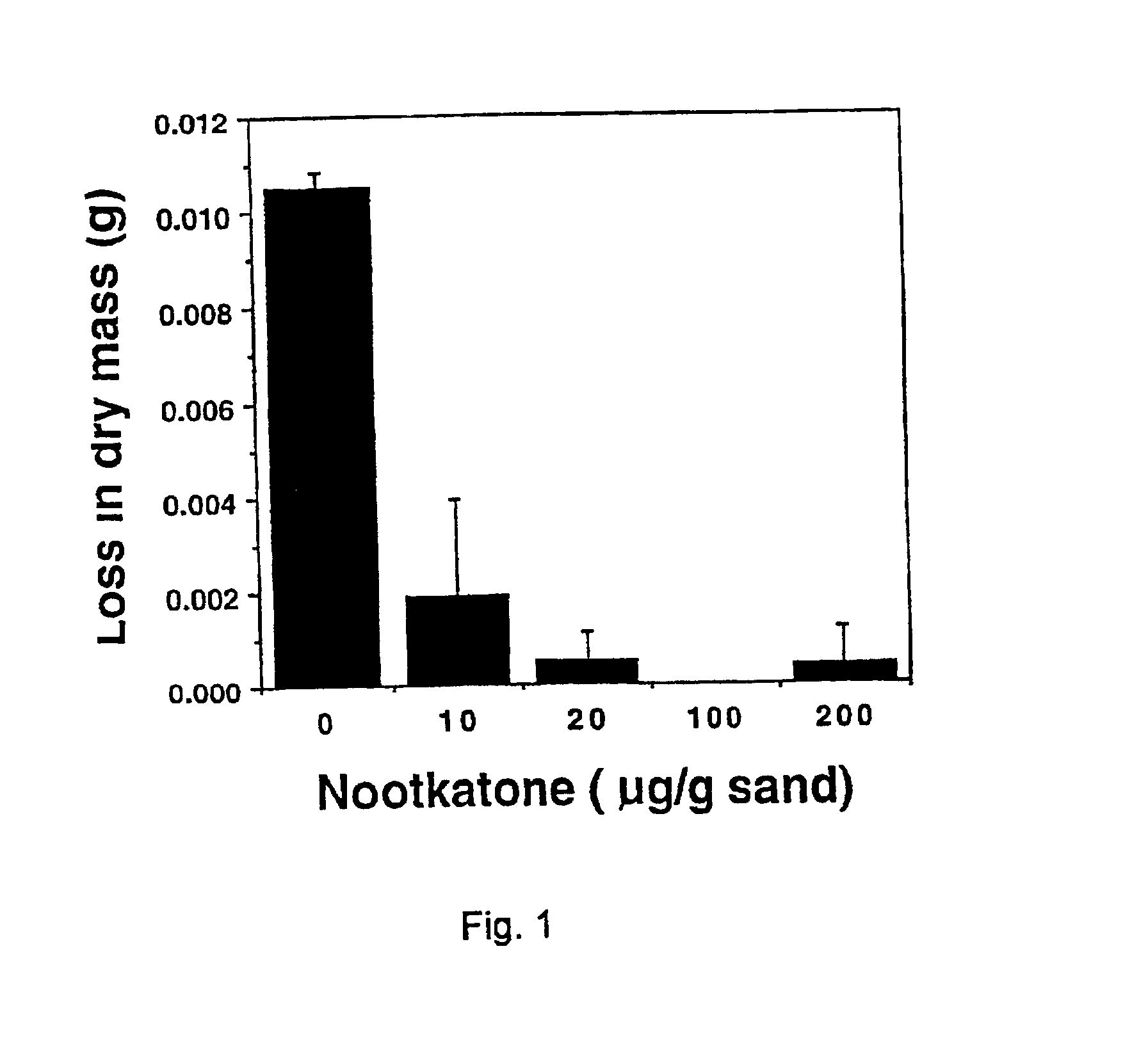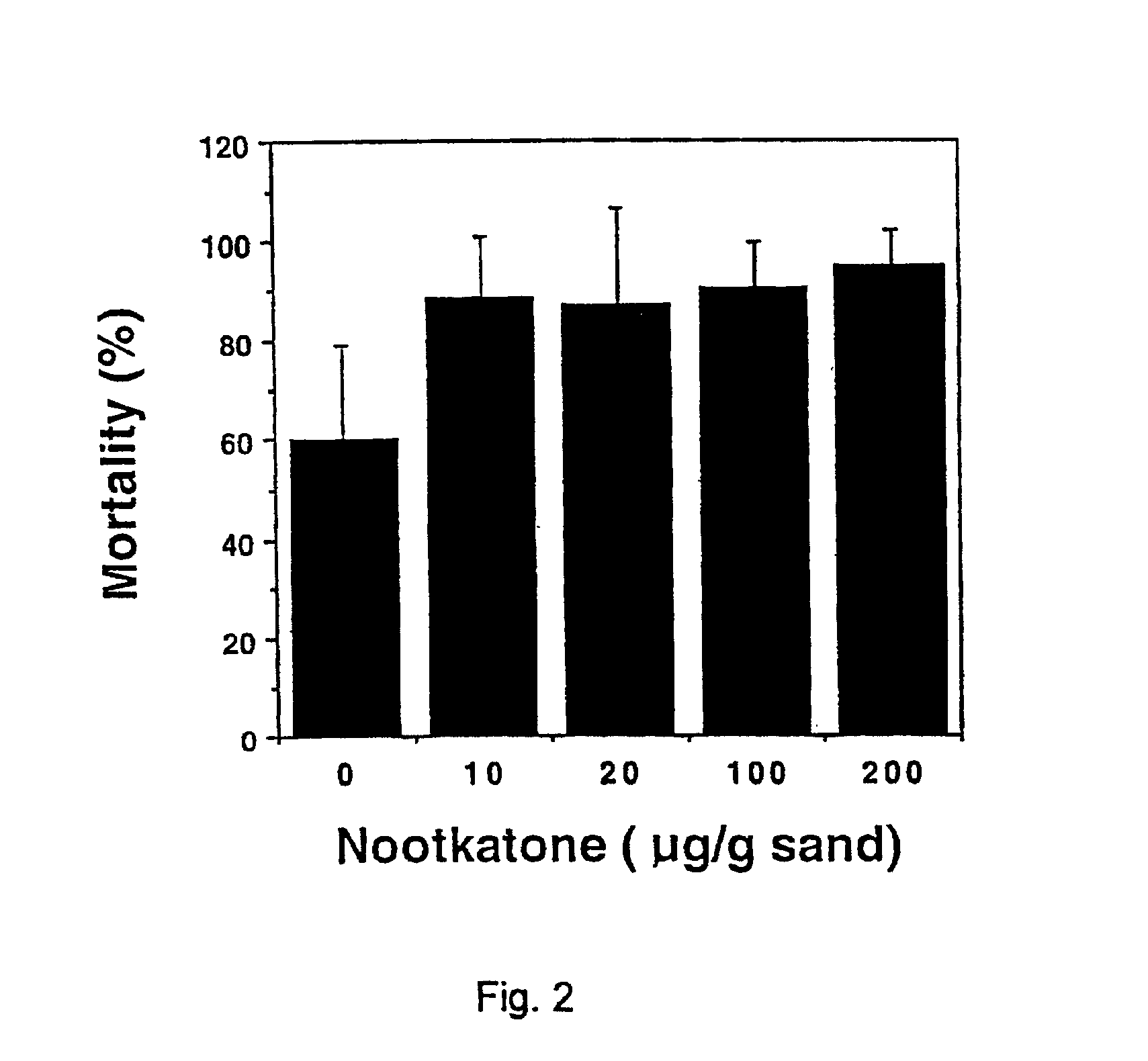Vetiver oil extracts as termite repellent and toxicant
a technology of vetiver oil and toxicants, which is applied in the field of vetiver oil extracts as termite repellent and toxicant, can solve the problems of significant decrease in food consumption, increased mortality of termites, and decreased tunneling behavior, so as to reduce food consumption, increase the mortality of termites, and reduce the effect of tunneling
- Summary
- Abstract
- Description
- Claims
- Application Information
AI Technical Summary
Benefits of technology
Problems solved by technology
Method used
Image
Examples
example 1
Extraction of Vetiver Oil from Roots
[0017]Vetiver roots from Louisiana grown Vetiveria zizaniodes (Donald O. Heumann Greenhouse and Laboratory, Poydras, La.) were cleaned, air-dried, and ground in a blender. The ground roots were stored at −20° C. for 3 to 6 months. After thawing, 5 g of ground vetiver root was added to 300 ml ethyl alcohol, and the mixture stirred for 24 hr at room temperature. About 250 ml alcohol extract was filtered through a 15 cm filter paper and concentrated by a rotor evaporator to approximately 3 ml. The concentrated extract was mixed with 3 g silica gel (60 Angstrom pore) and dried under a hood. A silica column (2×30 cm) was packed with the silica gel containing the vetiver extract packed in the bottom of the column. The compounds of the extract were separated by chloroform running upward overnight in a sealed chamber. The silica gel was then collected one inch at a time for seven fractions total. Each of the seven fractions was extracted with 50 ml ethyl ...
example 2
Termite Bioassay of the Extracts From Vetiver Oil
[0019]Forty-eight, three-chambered clear plastic containers were used to test the seven extracts from Example 1. Each rectangular chamber (17.5×8×4 cm; Pioneer Packaging Co., North Dixon, Ky.) was divided into three compartments with two inner walls. A small hole (0.5 cm diameter) was melted at the bottom of each of the inner walls to permit termite access to all chambers. The far left chamber was designated the “home compartment” and was filled with 115 g of #4 fine blasting sand (Easy Crete, Inc., Greenwell Springs, La.) to which was added 10 ml distilled deionized water (“ddH2O”). For a food source, a 55 mm #2 Whatman filter paper circle (Whatman International, Maidstone, England) was weighed and placed in the far right compartment. The center compartment was filled with sand that had been treated with one of the alcohol extracts from Example 1 or with only alcohol (the control). Each of the seven extracts was mixed with ethyl alco...
example 3
Isolation of Nootkatone From Louisiana-Grown Vetiver Oil
a. Vetiver Oil Extraction
[0030]Vetiver roots from Louisiana grown Vetiveria zizanioides were cleaned, air-dried, ground in a blender and stored at −20° C. One liter of petroleum ether was added to 20 g of dried vetiver roots and stirred for 24 hr at room temperature. The extract was filtered through filter paper and concentrated by rotor evaporator. The oil extract was then redissolved in 5 ml hexane.
b. Isolation of Components of Vetiver Oil
[0031]Components of the oil extract were separated using a 2.5×20 cm silica gel column, using a more efficient extraction than in Example 1. Five grams of vetiver oil were dissolved in 50 ml hexane and placed on a silica column that had been washed with 200 ml hexane. The extract was eluted with hexane and an increasing concentration of methylene chloride. Five fractions were isolated: fraction 1 eluted with a ratio of a 20:80 CH2Cl2: hexane; fraction 2, with a ratio of 30:70; fraction 3, wi...
PUM
| Property | Measurement | Unit |
|---|---|---|
| diameter | aaaaa | aaaaa |
| temperature | aaaaa | aaaaa |
| temperature | aaaaa | aaaaa |
Abstract
Description
Claims
Application Information
 Login to View More
Login to View More - R&D
- Intellectual Property
- Life Sciences
- Materials
- Tech Scout
- Unparalleled Data Quality
- Higher Quality Content
- 60% Fewer Hallucinations
Browse by: Latest US Patents, China's latest patents, Technical Efficacy Thesaurus, Application Domain, Technology Topic, Popular Technical Reports.
© 2025 PatSnap. All rights reserved.Legal|Privacy policy|Modern Slavery Act Transparency Statement|Sitemap|About US| Contact US: help@patsnap.com



